This article will look at 26 different types of sharks that live in our seas. We’ll highlight some of the biggest, scariest, weirdest, and rarest shark species known to man.
View in gallery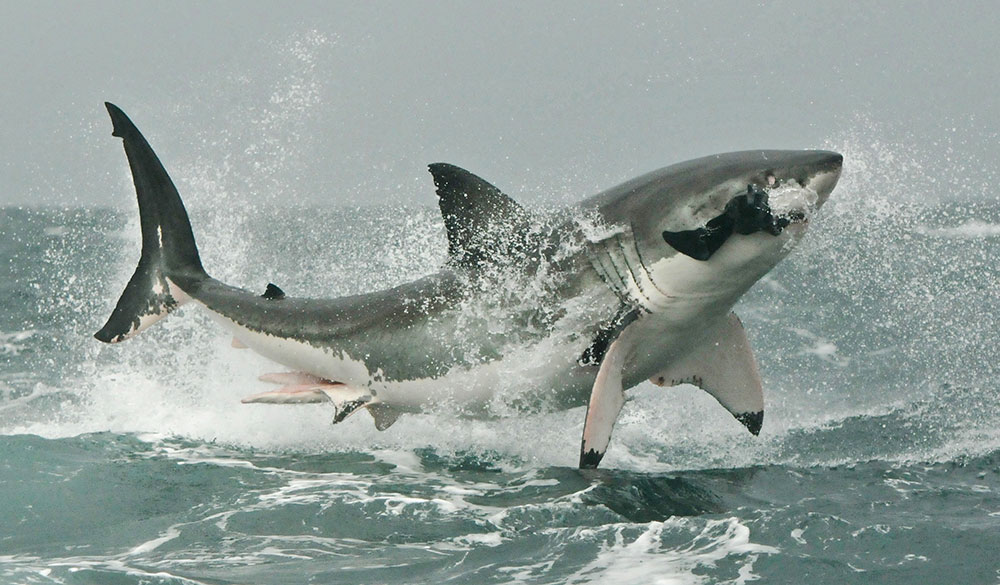
Each one of the different types of sharks is an amazing and unique creature. They are the ultimate predator; apex hunters and eating machines. Their entire existence is based on hunting and eating. (It’s a lifestyle I could get accustomed to myself.)
Sharks are beautiful animals, and they deserve our respect, love, and adoration. So, if you want to learn more about the different types of sharks, you have come to the right place. We might not be an oceanographic institute, but I freaking love sharks.
So grab your chum bucket, tie up the barrels and make sure you know the words to show me the way to go home because we’re going shark spotting!
Today’s guide on the different types of sharks is quite extensive. Jump to the section that interests you most:
- How Many Species of Sharks Are There?
- Shark Species of the Arctic Ocean
- Shark Breeds of the Atlantic Ocean
- Types of Sharks Found in the Indian Ocean
- Types of Sharks of the Pacific Ocean
- Species of Sharks of the Antarctic Ocean
- Gone But Not Forgotten: Extinct Shark Species
- What Drives Our Love Affair with Sharks?
- Fearsome Predators In Ever Dwindling Supply
- By the Numbers: Most Endangered Shark Species
How Many Species of Sharks Are There?
There are currently around 500 different types of sharks that have been classified. These different shark species are classified as belonging to 8 different ‘orders.’ For the scientifically inclined among us, these orders are:
- Carcharhiniformes
- Heterodontiformes
- Hexanchiformes
- Lamniformes
- Orectolobiformes
- Pristiophoriformes
- Squaliformes
- Squatiniformes
While we could base this article on the different types of sharks within each order, it feels more appropriate to base it on location. So we’re going to break things down into five of the seven seas.
Shark Species of the Arctic Ocean
The Arctic Ocean is the smallest of all of the earth’s oceans. It is also the shallowest, with an average depth of just over one thousand meters. However, it is still home to eight different shark species.
While sharks are cold-blooded creatures – in all senses of the word – they are not known for their love of cold-temperature water. Especially not temperatures as cold as the Arctic Ocean, where the average water temperature is just 28 degrees Fahrenheit. Typically, a shark’s preferred water temperature has been shown to be around 70 degrees.
That said, these eight hardened types of sharks brave the Arctic temperatures, although they do also stray down into the north Atlantic from time to time. The different shark species found in the Arctic Ocean include the stunning blue shark, the bluntnose sixgill, and the basking shark.
Out of all eight shark species found in the Arctic Ocean, only one is believed to call these frigid waters its primary habitat. Yet, it is also one of the most interesting and intriguing sharks on the planet.
1. Greenland Shark – A Gentle Giant
The Greenland shark is a remarkable animal. Not only is it hardy enough to call the Arctic ocean its primary home, but it has a lifespan that seems impossible. Indeed, scientists have discovered Greenland sharks live to be around 400 years old.
View in gallery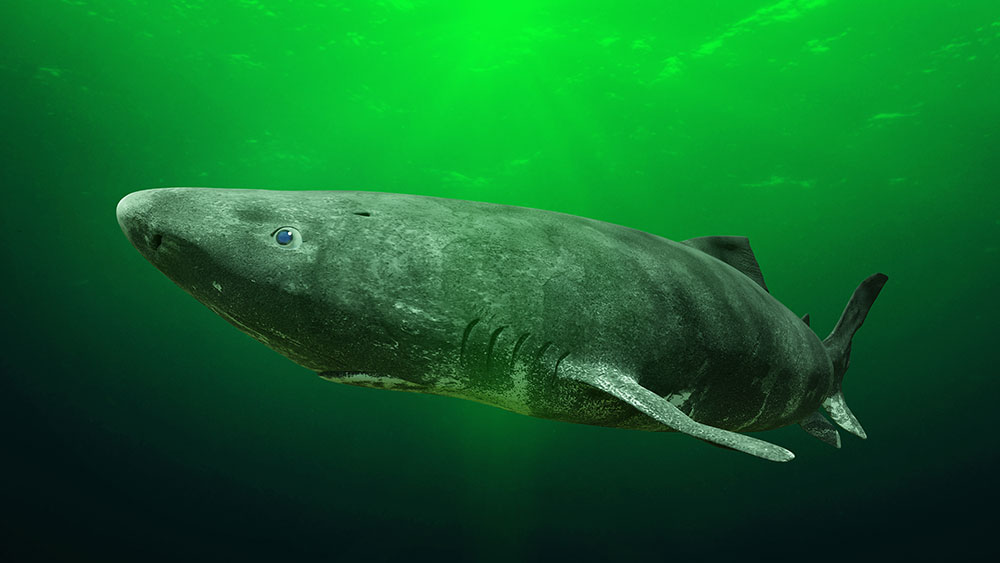
The Greenland shark is an evolutionary marvel, a docile shark that is sluggish and slow-growing in all aspects. Their laidback approach to life goes a long way to explaining their longevity.
It is believed that they grow at a rate of just 1cm a year. These seemingly placid sharks will reach maturity at around 150 years old, reaching a length of approximately 6 meters. This places them in the same sizing category as the fearsome great white.
However, despite their size, their docile nature means there are numerous examples of them being caught by hand by the Canadian Inuit.
With a diet that consists mainly of carrion, they are also known to feast on salmon and seals. Their technique for catching such speedy creatures is just one of the many mysteries surrounding this unique creature.
While this venerable shark species does not pose any real threat to humans, it is probably still not a great idea to jump into the ocean to try and make friends.
Did You Know – Three Facts About the Greenland Shark
- The current record holder for oldest shark of this species is believed to be approximately 500! This means that there are Greenland sharks out there born before King Henry VIII was king (let alone started down his course of marital discontent).
- They have been found swimming at 2,200 meters below the ocean surface.
- Their flesh is poisonous when eaten fresh.
2. Salmon Shark – Cousin to the King
Another shark that calls the Arctic Ocean its home is the Salmon shark. While it is more commonly found in the North Pacific, it has a penchant for cooler water and has a much smaller range than the other sharks on this list.
The salmon shark has a naturally higher body temperature than many different types of shark, meaning it can hunt for food in arctic waters. The shark also has the somewhat unique ability to regulate its body temperature.
View in gallery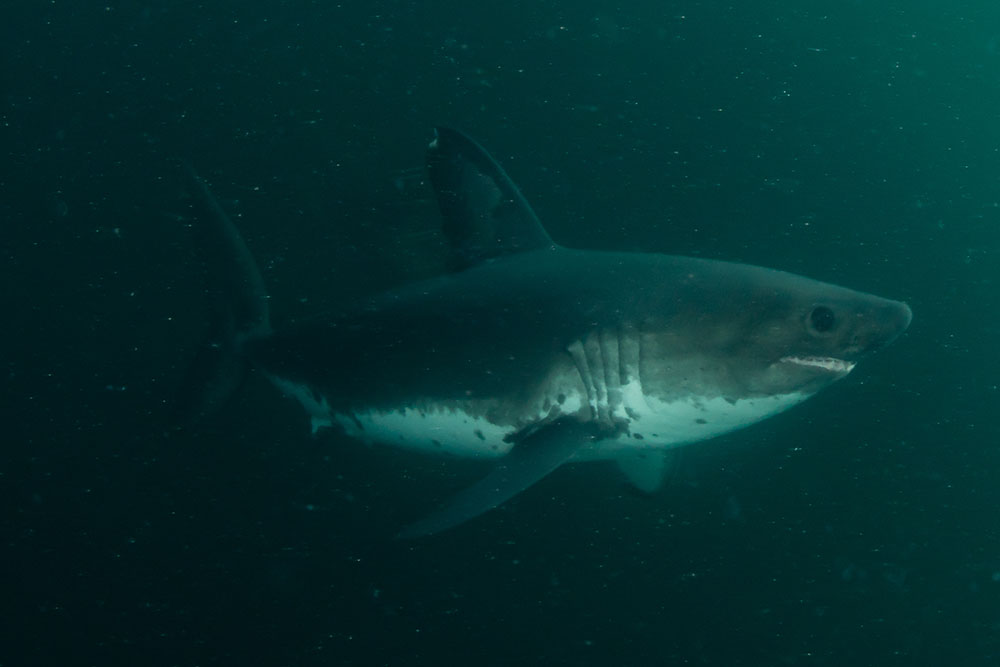
While technically a form of mackerel shark, it is also a cousin to the king of the aquatic jungle, the great white shark. However, despite these family ties, there is no denying the salmon shark cuts a far less imposing figure.
Interestingly, there are significant differences noticed between both age and sex ratios between groups in the eastern part of the North Pacific Ocean when compared to their western-based counterparts. As with many types of sharks, mature females are often slightly larger than males, with the average size falling between 6’6 and 8’6.
Much like the Greenland shark, Salmon sharks do not pose much of a threat to humans, with almost no reported incidents each year.
However, should you happen to spot one, we suggest steering clear, just in case.
Did You Know – Three Facts About the Salmon Shark
- Salmon sharks are a type of mackerel.
- They are close relatives to both the great white and the mako shark yet are the only known species of their type.
- Salmon sharks have binocular vision.
Shark Breeds of the Atlantic Ocean (North and South)
Ah, the Atlantic Ocean. One hundred six million square kilometers of shark-infested goodness. It is a paradise for sharks of all shapes and sizes, accounting for close to thirty percent of the world’s water area and twenty percent of the earth’s surface area.
Out of the 500 or so different types of sharks on this planet, the Atlantic Ocean plays home to the majority of them. That’s not entirely surprising given the size of the ocean and the range in temperatures, stretching from Canada down to South America. So everything from your common dogfish up to the unrivaled Ace of the Atlantic, the great white can be found in this stretch of water, making it a treasure trove for shark fans.
While the knowledge of so many shark species might be enough to deter many people from taking a summer dip, for those interested in sharks and the different types of sharks that are around, this ocean is an excellent place to focus your attention and research.
We’ve even done some of the legwork for you and compiled a list of the biggest, baddest, and weirdest Atlantic sharks.
3. Whale Shark – The Gentle Giant
The Whale shark is the biggest type of shark we know about that is still alive today. They are gentle giants and always a popular attraction for scuba divers and snorkelers in and around the more tropical areas where they are known to congregate.
View in gallery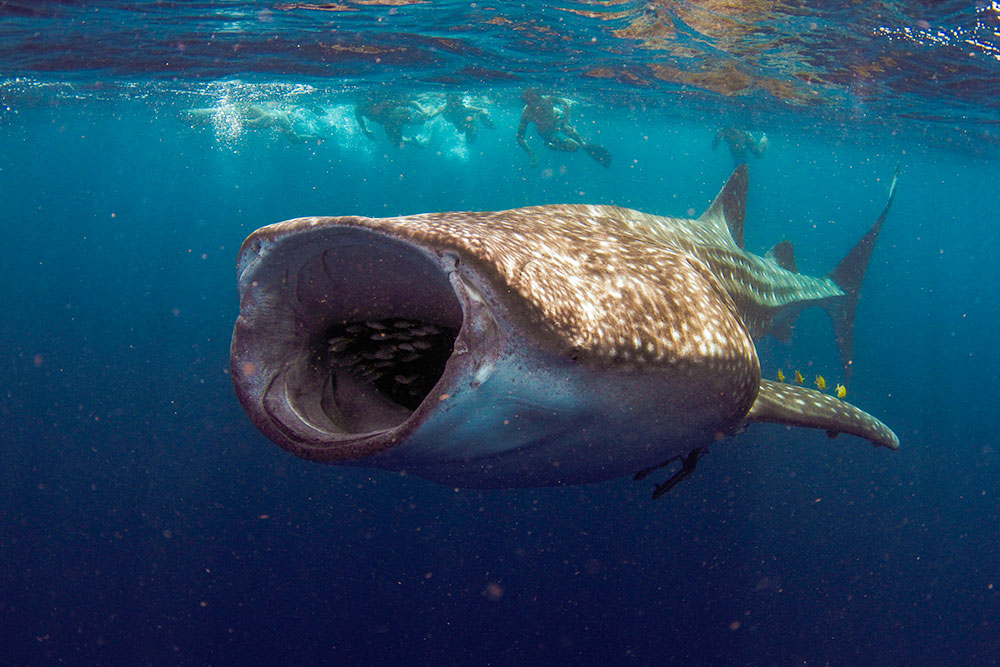
One of the many sharks on this list found in more than one ocean, the whale shark is often easily spotted off the Mexican and Australian coasts. Not counting their massive size, their unique spot and stripe markings make them one of the easiest types of sharks to identify.
There are many unknowns surrounding this gentle giant of the sea, such as how it births its young, where and the rate at which they mature. There has never been a live sighting of a whale shark’s birth.
While the exact maximum size range of a mature whale shark is not known, many believe they could conceivable reach 20m.
There are fishing restrictions in place to protect this beautiful creature. However, their numbers are still declining year on year.
Did You Know – Three Facts About the Whale Shark
- Whale sharks can live to be 150 years old. However, sadly many of these fantastic beasts do not survive long enough to reach adulthood.
- Despite its size, the whale shark is a filter feeder and cannot bite or chew. Instead, they filter up to 6,000 liters of water an hour, catching small fish and shrimp in their gills.
- Speed is not their most significant attribute. Whale sharks only swim at around 3 miles an hour which is around half the average shark cruising speed.
4. Hammerhead Shark – The Moose of the Sea
The Hammerhead shark is a tricky one to add to the list because there are many different sharks that fall under the “hammerhead” designation. In total, there are ten different types of hammerhead sharks. These range in size from under a meter to over 6 meters, depending on their family.
View in gallery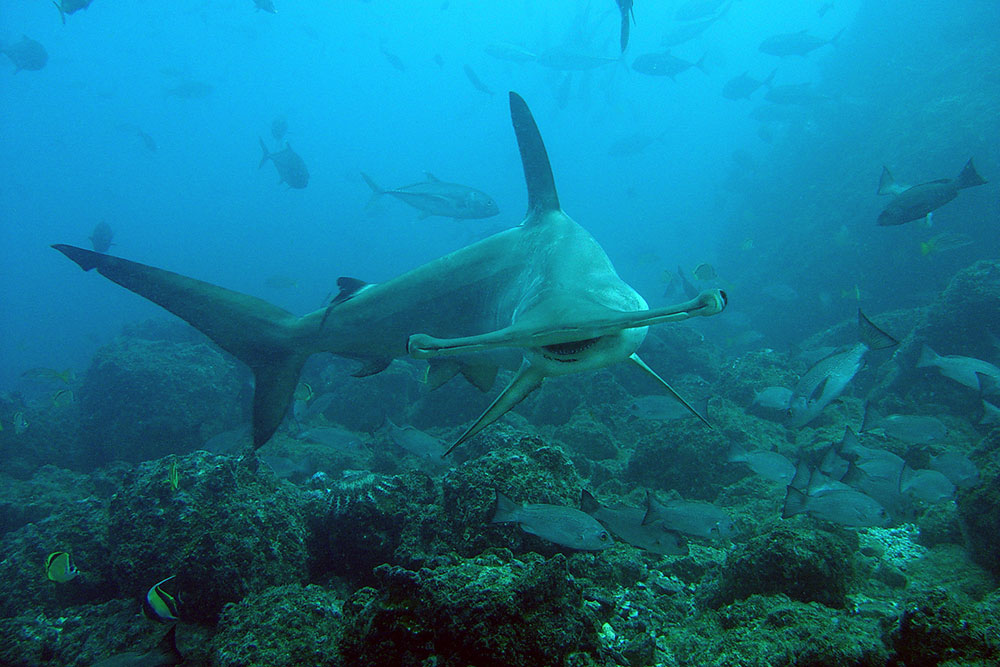
Without question, hammerheads are the most distinctive type of sharks, given their namesake-shaped head.
Besides looking cool, their unique head acts as a form of hydrodynamic bow plane. This means the shark can turn on a dime, giving it extreme maneuverability.
A herd fish, some species shrug off the solitary image of most sharks and swim in schools. In some of the larger species, these groups can be segregated by sex.
Despite their (average) size, hammerheads are coastal fish, meaning they stay close to land and only rarely venture out into the deeper waters of the open ocean.
Their diet consists mainly of squid and crustaceans. However, some larger species of hammerhead are known to eat stingrays. There are numerous examples of mature hammerheads being found with stingray barbs embedded into their bodies.
Often killed by humans for their meat, overfishing and unregulated fishing is a significant threat to this beautiful shark species.
Did You Know – Three Facts About the Hammerhead Shark
- The hammerhead shark has a 360-degree vision.
- A female hammerhead shark can give birth to up to 50 pups at a time.
- Hammerheads use their head to their advantage and pin prey to the sea bed in order to get a solid bite.
5. Mako Shark – Speed Demon
The mako shark is the fastest type of shark–and an apex predator thanks to it.
A fully mature mako shark can grow up to 3.8 meters in length. While not the biggest, it is a fast and agile predator that eats pretty much anything it can, from squid and carrion to other sharks, sea turtles, aquatic mammals, and small fish.
View in gallery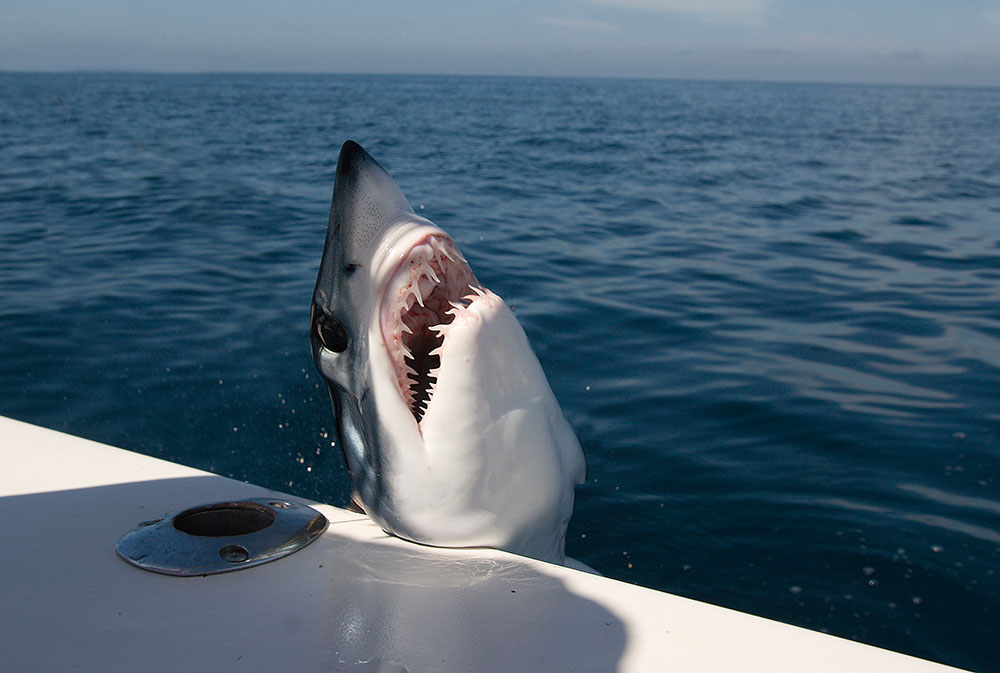
The mako is a member of a very selective group of sharks and fish because they have the ability to maintain a body temperature that is higher than the surrounding water. What this means is that they are adept hunters in colder waters.
While they might not be as well known or as popular with movies and fiction creatives, the mako shark is at the top of the open water food chain (the pelagic food web). This means they have no natural predators.
There have been a small handful of mako attacks on humans, but these are not considered direct predation but rather cases of mistaken identity. However, due to many different factors, including human predation, Mako sharks are close to being classified as an endangered species.
Did You Know – Three Facts About the Mako Shark
- The mako is the fastest shark in the world–and one of the fastest fish.
- Mako sharks only give birth around three times in their life.
- Mako sharks are one of just give shark species to be warm-blooded.
6. Bull Shark – The Pitbull of the Sea
Nicknamed the pitbull of the sea, the bull shark is an aggressive shark that has no problem attacking humans. Yes, shark attacks are rare, but the bull shark is still one of only three species that will consciously attack humans.
Yet, in an interesting twist, humans do not pose a threat to the bull shark; there are no known active fishing practices for this shark species.
View in gallery
To add further weight to the diversity and magic of all the different types of sharks, the bull shark is one of just 43 types of sharks that has low salt concentrations in its blood.
These low salt levels mean the shark can live in both fresh and saltwater, ranging in and out of both as they move.
A mature male bull shark will grow to around 3.5 meters, with the females being the larger and dominant member of the species.
Did You Know – Three Facts About the Bull Shark
- They have a stronger bite than the great white shark.
- A bull shark was likely the real inspiration for Jaws.
- They are a common shark with no active protection in place.
7. Goblin Shark – The Ugly One
Earlier in this post, I said that sharks were beautiful and majestic creatures. Well, the goblin shark is the exception that proves the rule.
This is one ugly ass shark! There’s no gentle way to say it. Their long snout, thick, ungainly jaws, and misshapen teeth make them an easy shark species to identify. Unfortunately, despite their obvious need for a good orthodontist, we do not know much about these weird creatures.

With small, almost misformed fins and a soft, often flabby body, these creatures do everything they can to avoid all classic shark characteristics.
Very little else is known about these secretive sharks. However, it is believed they give birth to egg-developed live young and feed mainly on a diet of crustaceans and squid.
The goblin shark is so strange looking to even go beyond the ‘so ugly it’s cute’ classification. Yet, it is precisely its horrifying appearance that makes it such a fascinating creature.
Did You Know – Three Facts About the Goblin Shark
- The common name for this shark is derived from a Japanese demon
- They have an elastic lower jaw that shoots forward to bite the prey and then slingshots back into place.
- Their skin is transparent, which gives them a distinctive pink coloration.
8. Nurse Shark – The Suction King
A small-mouthed bottom feeder, this shark gets its name from the slurping ‘nursing’ sound it makes as it sucks its prey from the sea bed. Despite their inability to eat large prey, the nurse shark is a large species. Adults can grow up to 4.5 meters in length.
View in gallery
Generally, a shallow-water fish that loves the warmer waters of the Caribbean islands, it is most active at night.
A strangely social fish, they group together during their close to dormant daylight periods; however, they become far more solitary once the sun goes down.
No commercial fishing practices currently target the nurse shark; however, there are instances of it being fished for its thick skin and liver oils. In addition, nurse sharks are slow swimming which makes them a relatively easy target for fishermen.
Did You Know – Three Facts About the Nurse Shark
- Nurse sharks do not need to keep moving in order to breathe. Instead, they suck water into their mouths and over their gills, taking the oxygen they need to live while remaining perfectly still.
- They are a direct relative of the whale shark.
- Female nurse sharks only mate once every eighteen months.
9. Silky Shark – Smooth As …
Named so because of the smooth silk-like texture of its skin, the Silky shark is a large fish that can reach 3.5 meters when fully mature. The silky shark is a near-perfect predator, thanks in large part to its exceptional hearing.
View in gallery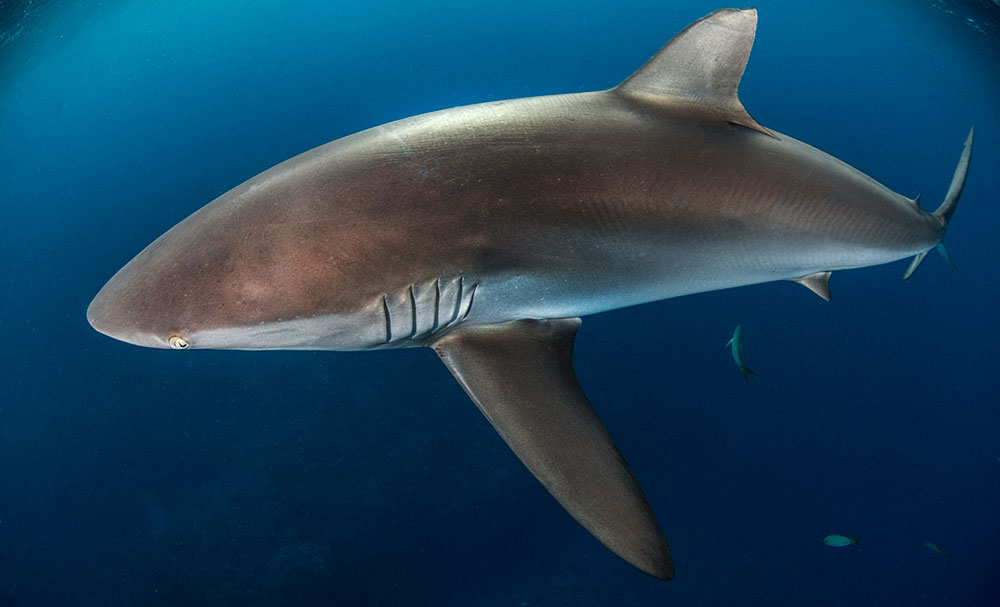
Silkies attack in groups diving down into their prey open-mouthed and ravenous. Their preferred diet consists of tuna, squid, and octopus.
The silky shark will not attack humans unprovoked, but is not shy and poses a credible threat to divers.
Silky sharks give birth to live young, and their young will often live within the security of a reef before venturing out into the open ocean as juveniles. However, despite a solid reproduction cycle, rapidly dwindling numbers could see this fish classed as endangered before too long.
Did You Know – Three Facts About the Silky Shark
- Silky sharks only give birth between June and August each year
- They have a relatively small litter size between 6 to 14 pups
- They have a wide geographical range and are found in the Atlantic, Pacific, and Indian oceans
10. Great White Shark – The Mighty White
The Shark Week superstar is the ultimate killing machine and, without question, the most famous shark on the planet.
View in gallery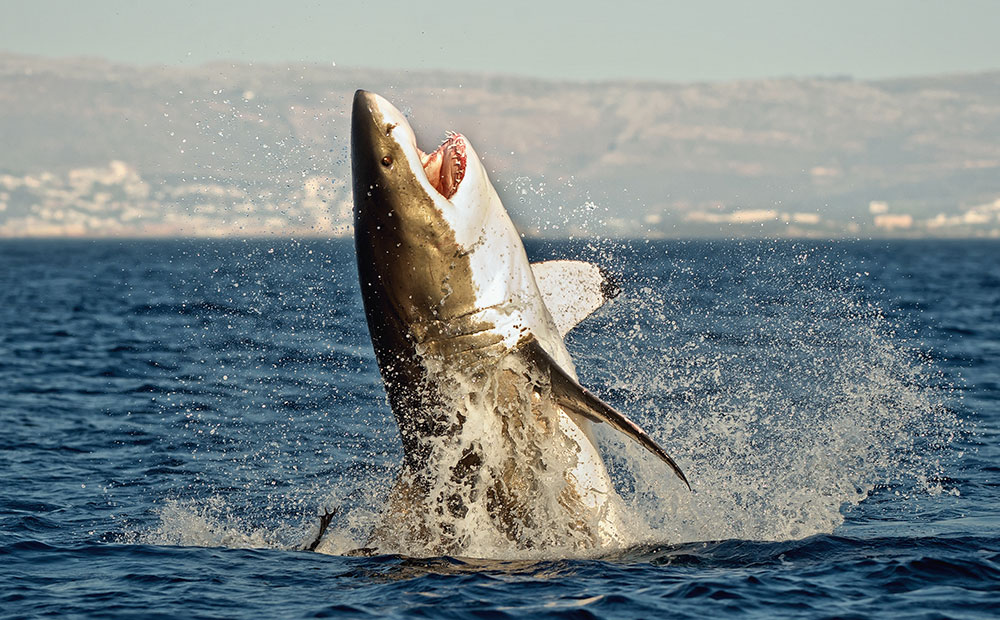
The great white is one of the most advanced predators on earth. Villainized by the movie Jaws, the image painted of this majestic shark species paints it in a rather bad light. The truth is great white shark attacks on humans are rare and often a case of mistaken identity.
Despite their immense size (around 6 meters), the great white can cruise around at 15 mph and can be found all over the world. There are not many areas of the ocean where a great white has not been seen.
What I find interesting is that despite the notoriety of these fantastic beasts, there is still so little known about their reproduction. Great white sharks live to around 30 years and give birth to egg developed young.
Did You Know – Three Facts About the Great White Shark
- The great white shark young hunt and kill weaker siblings while still inside their mother’s womb.
- They can smell blood in the water from over 3 miles away.
- Great white sharks have over 300 teeth in their mouth and will lose over 1,000 during their lifetime.
Types of Sharks Found in the Indian Ocean
The third-largest ocean on earth, the Indian Ocean, stretches from Antarctica up to Africa and across to Asia and Australia. All totaled, this massive body of water covers 70,500,000 square kilometers, accounting for almost twenty percent of the earth’s water surface area. This also includes being bordered by seven different marginal seas, including the Arabian Sea, the Java Sea, the Bay of Bengal, and the Persian Gulf.
Given that there are not always clear definitions between bodies of water, many sharks already mentioned as belonging to the Atlantic Ocean also call the Indian Ocean their home. Such deadly predators as the bull shark and great white are often found in the tropical climbs of the Indian Ocean. In fact, some parts of the Indian Ocean are considered to be the most shark-infested waters in the world.
The following sharks are all found primarily within the boundaries of the Indian Ocean and are a testament to the wide variety of sharks that share this planet with us.
11. Tiger Shark – Mr Bad Attitude
The tiger shark is another vicious predator, and alongside the bull and great white, it is the other only shark that will attack humans without a thought.
View in gallery
A fully mature tiger shark can grow to around 5 meters and weigh in at over 1,800 pounds. The shark prefers the warmer waters of the Indian ocean. However, there have been sightings off of Cape Cod and the coast of Japan.
Despite the fact that they can attack humans, the concept of them being man-eaters is again somewhat mythical. Shark attacks of any sort are extremely rare and usually as a result of people feeding the sharks in order to get them to congregate in a specific area—a largely illegal process.
Tiger sharks are nocturnal animals, which means they hunt at night. This, combined with their dark coloration, makes them a stealthy predator, which is handy as they are not one of the fastest swimmers.
Did You Know – Three Facts About the Tiger Shark
- Despite their name, most tiger sharks don’t have stripes. While they appear on juveniles but fade by adulthood.
- Tiger sharks are pregnant for 16 months and give birth to an average litter size of 30 pups.
- Their teeth are notched rather than holding the classic shark tooth look. They are also mirror images on the left and right-hand sides.
12. Oceanic Whitetip Shark – The Dangerous One
The ocean was once full of oceanic whitetip sharks; however, humanity has driven them close to extinction. The fin trade has seen the numbers of oceanic white tip sharks fall by an estimated 90%. This shark species lives out in the deep waters of the open ocean, and as such, attacks on humans are infrequent.
View in gallery
Mature female sharks will reach around 2.7 meters in adulthood, which is a good 30cm longer than adult males.
A large shark that likes to stick close to the surface, it is a fearsome predator with large fins. This type of shark eats pretty much anything, from sea turtles and squid to barracudas, tuna, and marlin.
An opportunistic predator, the oceanic whitetip will never pass up an opportunity to grab a bite to eat.
Did You Know – Three Facts About the Oceanic Whitetip Shark
- Unlike other sharks, the oceanic whitetip’s fins are wide and round rather than pointed.
- Jaques Cousteau regarded them as the most dangerous of all sharks.
- Despite being high-level predators, they are by nature very slow swimmers.
13. Zebra (Leopard) Shark – The Aquarium Favorite
The leopard shark is a shark that many people will recognize. Not just because of its interesting coloration but because it is a staple addition to any commercial aquarium. These normally bottom-dwelling fish are one of the lucky types of sharks who can rest and still breathe underwater. Often, they turn to face the flow of the current to keep water flowing over their gills.
View in gallery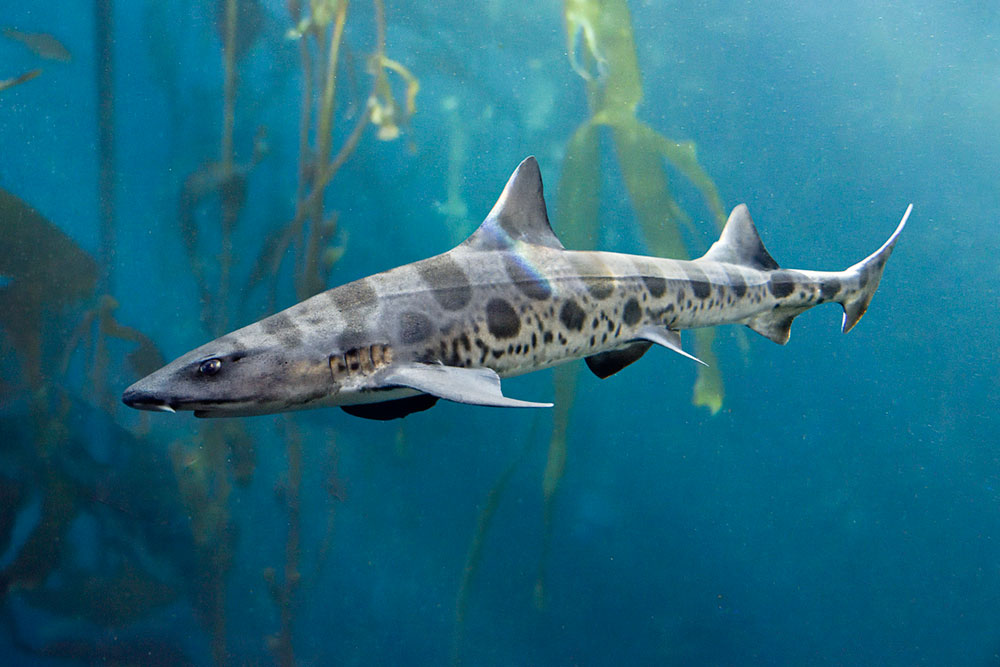
The Leopard shark is a peaceful fish that can grow to around 3.5 meters in length.
It is a slow and often quite timid creature who likes the safety offered by coral reefs as they provide plenty of places to shelter. A nocturnal animal, the leopard shark is just as often prey as it is predator.
Despite being a common fish, population levels of zebra sharks are declining, in large part due to commercial fishing. This shark species is often caught for its fins, flesh, and liver oils, as well as for use in producing fish meal.
Did You Know – Three Facts About the Zebra Shark
- This shark is also called a leopard shark as its signature stripes fade as they age, becoming spots once they reach maturity.
- Amorous male zebra sharks will repeatedly bite the fins of a female.
- Zebra sharks lay eggs in large batches. Then, they anchor the eggs to coral reefs to keep them safe until it’s time to hatch.
14. Spinner Shark – The Acrobatic One
The spinner shark is a highly migratory shark that loves the warmer waters of the Indo-Pacific and the central Atlantic – around the Mediterranean and the Gulf of Mexico. One of the inshore shark breeds, the Spinner rarely likes to venture into water deeper than 350 feet.
View in gallery
Spinner sharks often form small groups as they migrate and can often be seen traveling inland through to the Gulf of Mexico.
They hunt by charging up into schools of fish, leaping out of the water as they snatch at anything their jaws can reach. Despite their aggressive hunting techniques, they pose no real threat to humans.
Unfortunately, the spinner shark is one of the many different types of sharks whose numbers are dwindling due to commercial fishing. To make it worse, they are often confused – and their meat sold – as blacktip shark, making it harder to gauge fishing numbers.
Did You Know – Three Facts About the Spinner Shark
- Their name comes from how they spin around several times when leaping from the water to hunt prey.
- Spinner sharks can jump around 6 meters (20 feet) into the air.
- Their fins are very popular in the Asian delicacy, shark fin soup.
15. Megamouth Shark – The Mouthy One
A very rare and mysterious shark, the megamouth reaches 5 meters and around 2,100 pounds when mature. Despite this, it is the smallest of the three filter-feeding types of sharks. It gets its name from having a 1.3-meter wide mouth, which is perfect for swallowing large amounts of water and food.
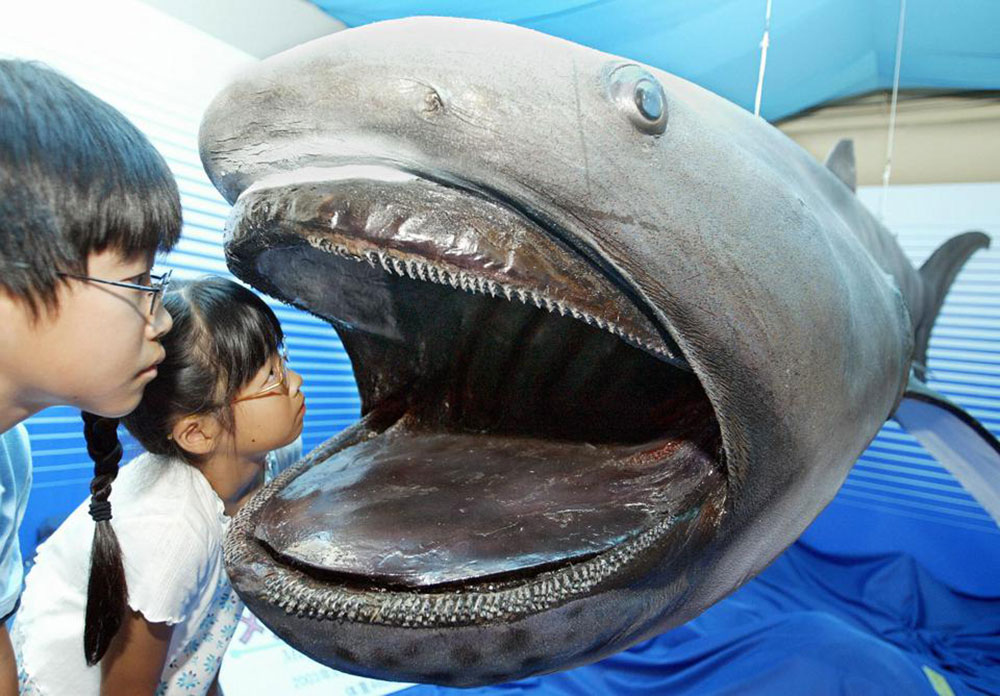
Despite being one of the largest shark breeds, the megamouth shark is rarely seen, and as such, remains something of a giant enigma.
There have been just a handful of instances of this shark being captured. However, as deep-sea fishing pushes deeper and deeper, expect that number to rise.
Despite there being no commercial fishing practices for this shark species, they are sold for their meat when landed accidentally.
The megamouth shark is a flabby and awkward-looking creature, and as a result, is a notably poor swimmer. It has small soft finds and an asymmetrical tail to boot.
Did You Know – Three Facts About the Megamouth Shark
- The first megamouth shark was seen in 1976.
- There have been just 55 confirmed sightings since then.
- It has 50 rows of teeth on each jaw, but only the front three rows are functional.
Types of Sharks in the Pacific Ocean
The Pacific Ocean is the largest body of water in the world. It covers a staggering 165 million square kilometers. To put that into perspective, the Pacific Ocean covers more surface area than the total of all of the continents combined. Just let that sink in for a moment.
There is no place on earth with a more diversified ecosystem than the Pacific Ocean, so you know what that means. Sharks, and lots of them. There are thirty-four recorded types of sharks off the North American Pacific coast alone.
This body of water also plays home to the ‘Red Triangle,’ which is an area of sea off the Californian coast that is home to a large number of seals and other such marine mammals. As a result, it is also a hotbed for great white shark activity. In fact, it is within this triangle that almost forty percent of all great white shark attacks happen.
Random thought – What is it with triangular bodies of water causing such trouble on the American coast?
With that in mind, let’s take a look at some of the different types of sharks inhabiting the Pacific Ocean.
16. Crocodile Shark – The Snap Happy One
The crocodile shark is a small open-water shark that loves the warmer waters of all the major oceans. The crocodile shark gets its name from the way it snaps its jaws when pulled from the water.
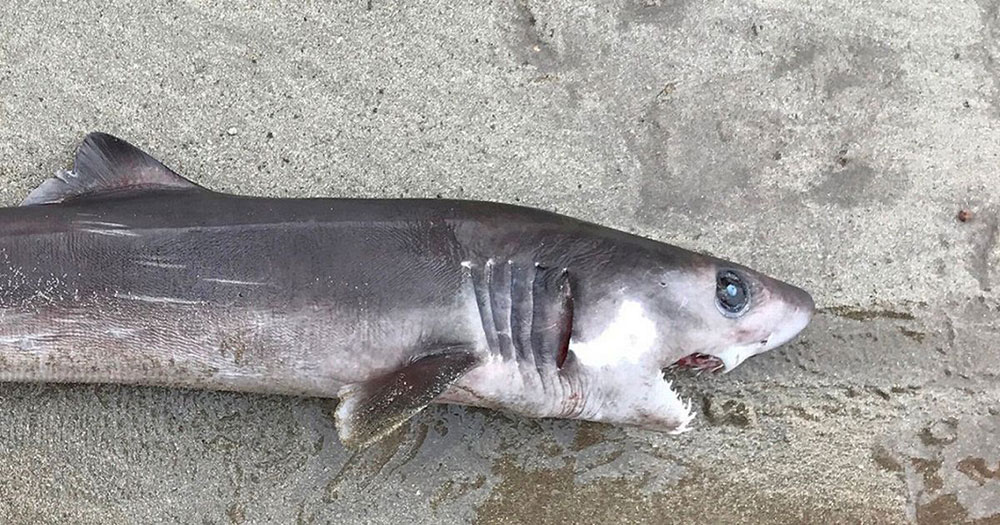
Despite living out in the deep waters, it is a small shark rarely getting longer than 1 meter. Their diet consists mainly of small fish and squid. They have large eyes, and it is widely believed that they are visual hunters.
Unlike many types of sharks, the crocodile shark doesn’t give birth to large litters. Usually, a female will give birth to between 1 to 4 pups. They are born live, and it is believed they are nourished by the mother using unfertilized eggs.
Given their size and deep-sea location, crocodile sharks pose no real threat to humans. However, caution would always be advised given their powerful jaws and natural predatory nature. There is very little known about their population levels; however, they are not considered endangered or threatened.
Did You Know – Three Facts About the Crocodile Shark
- Crocodile sharks have a protrusible jaw that shoots forward to snatch at prey.
- They have no swim bladder and instead rely on high liver oil levels to maintain buoyancy.
- They are prized for their liver oils, yet there are no active commercial fishing practices around the crocodile shark.
17. Horn Shark – The Lazy One
The horn shark is another small shark that rarely grows beyond 1 meter in length. Interestingly, unlike many other shark breeds, they have a very small habitat. They rarely stray from the same 1,000 square meter area.
View in gallery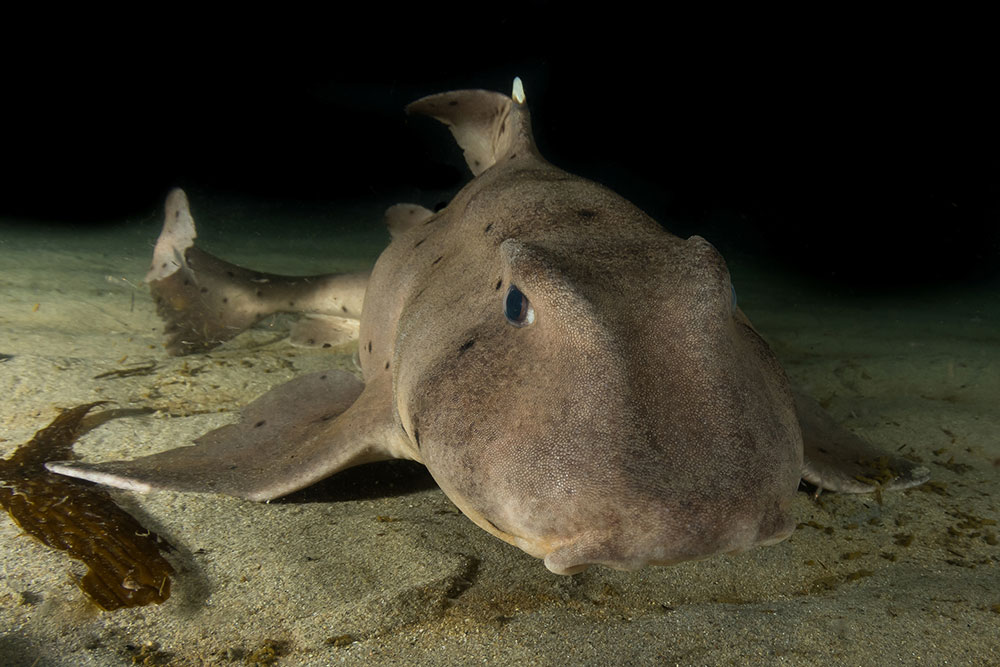
Horn sharks are bottom-dwelling sharks with broad, muscular fins that help them move along the seabed. While not officially nocturnal creatures, they are certainly more active at night and prefer to remain relatively still during the day.
The horn shark has a breeding cycle that is different from many other shark species.
Rather than birthing large litters, the horn shark will instead lay two eggs every fortnight between February and April. Once fertilized, these eggs will develop for between 6 and 7 months. The exact rate of embryo growth is dependant on the ambient water temperature.
Did You Know – Three Facts About the Horn Shark
- The furthest distance a monitored horn shark has ever traveled is just 10 miles.
- The spines in their fins are highly prized for the making of jewelry.
- They have a combination of shape and flat teeth.
18. Thresher Shark – The One With the Tail
There are three primary Thresher shark species, all of which have their name from their colossal tail fin. However, the existence of a fourth thresher shark species remains a hotly debated topic in oceanographic circles.
View in gallery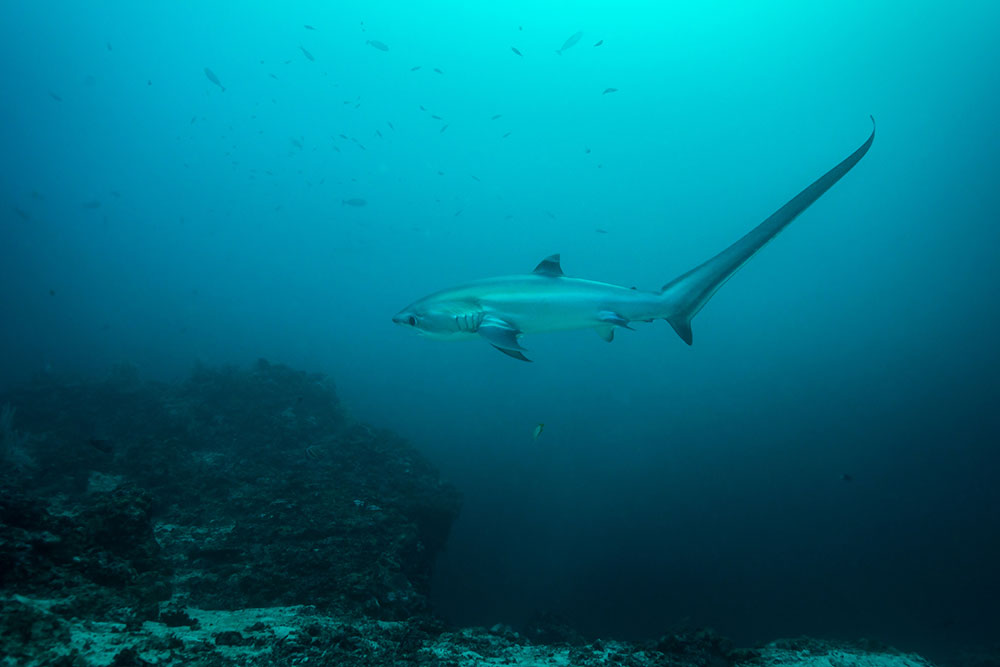
There is a lot that is not known about the Thresher shark. They can grow to around 6 meters and live to their early 20’s however it is widely believed and accepted that they could live much longer. There is just no data to show it. Despite being open water sharks, Threshers don’t often venture beyond a depth of 500m and are commonly found in shallower coastal waters.
Thresher sharks use their large tail fins as a weapon, using it first to confuse and then stun their prey.
Their numbers are sadly in a steady decline, thanks mainly to fishing. A target of sports fishing, and a typical commercial fishing bycatch, recent laws have been introduced aiming to protect this mysterious shark.
Did You Know – Three Facts About the Thresher Shark
- Their large tails are often larger than the length of their body.
- Thresher sharks are a descendant of the mighty Megalodon!
- Thresher sharks are one of just a handful of warm-blooded shark species.
19. Pygmy Shark – The Baby of the Bunch
Now we go from a descendent of the largest shark to ever exist to the second smallest shark species. Fully mature pygmy sharks rarely grow larger than 30cm, yet, despite this, they are deepwater sharks.
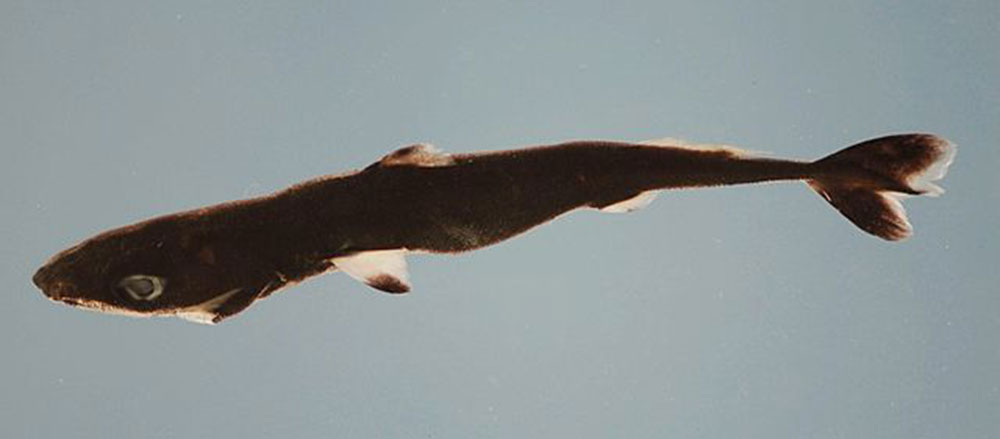
They are commonly found in water depths of around 1,500 meters. Interestingly enough, they spent their day down in the depths and ascend to the surface during the night.
Feeding on small squid and bony fish, they are deceptively vicious predators.
Given their size and deepwater habitat, the pygmy shark is not considered a danger to humans, and it is not part of any commercial or even recreational fishing practices.
Did You Know – Three Facts About the Pygmy Shark
- They have a bioluminescent underbelly to help them hunt prey.
- For centuries they were the smallest shark species before the discovery of the dwarf lantern shark.
- They are one of the few shark species that are not threatened or endangered.
20. Cookiecutter Shark – The Terrier of Sharks
Also known as the cigar shark due to the cigar-like shape of its body, the cookiecutter shark is a member of the dogfish family. It gets its name from the cookie-shaped bitemark it leaves on its prey.
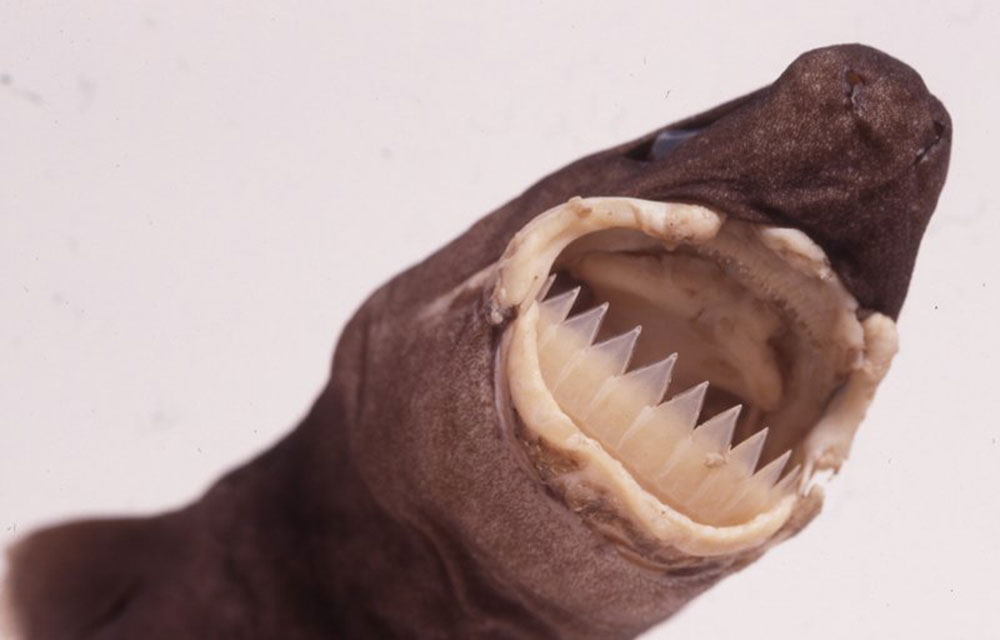
A mature cookiecutter shark will only grow to around half a meter in length. Yet, it is an aggressive predatory regularly taking chunks out of whales and larger sea mammals.
Despite their size, the cookiecutter shark loves to swim in deep water, typically found at around 3,200 feet. However, they have been times when they have been noticed as deep as 3.7 km!
We don’t know a lot about the cookiecutter shark, but it is believed to be an abundant population given the lack of interest in the shark for its meat or oils. In addition, given its small size, it poses no danger to humans.
Did You Know – Three Facts About the Cookiecutter Shark
- It has the largest teeth of all the different types of sharks, relative to its body size.
- The cookiecutter shark will often attach to submarines and try to eat the sonar domes.
- It is believed that the cookiecutter shark will swallow its own teeth and ‘recycle’ them to strengthen its cartilaginous skeleton.
Species of Sharks in the Antarctic (Southern) Ocean
Much like its northern brother, the Antarctic Ocean is not the most hospitable of ecosystems for sharks. In fact, unlike the Arctic Ocean, which has the above discussed Greenland Shark, there are no known types of sharks that live in the Southern Ocean. This makes sense when you factor in that the Antarctic Ocean is the coldest and windiest ocean on earth–rough conditions for both predator and prey alike.
The reason for the lack of shark activity in the southernmost point of the globe is primarily believed to be due to the extreme cold temperature. Most shark breeds need to move to breathe. So a shark is constantly moving from the day it is born to the day it dies.
If a shark were to try and swim through, let alone make a home in the icy Antarctic waters, their energy levels and base metabolism would drop so much, so fast, that they would not have the strength needed to swim.
Just to give you a little perspective, the Antarctic Ocean is so cold, it’s not uncommon for underwater brine icicles to form. These fast-growing icicles are made from the salt released from the seawater when it freezes on the surface. This brine shrinks, freezing the water around it to form giant icicles that stretch to the sea bed. Furthermore, these icicles or brinicles will freeze any animal they come into contact with also.
Of course, global warming is changing the temperature all over the world, but still, it will take a long time before the frozen waters of the south are accommodating enough for sharks.
Gone But Not Forgotten: Extinct Shark Species
While modern-day sharks are marvelous creatures, I just couldn’t write an article about sharks without mentioning some of the most fearsome examples of this ancient species that are sadly (or thankfully) no longer with us.
Sharks have roamed the earth for over 400 million years. That’s longer than the oldest dated tree on this planet. It’s only natural, therefore, that a few shark species have been lost along the way. So in this section, we will take a look at the different types of sharks from yesteryear that are sadly no longer with us today.
21. Stethacanthus – Submarine Shark!
A prehistoric shark, Stethacanthus, is instantly recognizable by its anvil-shaped dorsal fin. In addition, their body, including the top of this fin, was covered in sharp spines. It is believed that these were the precursor to the placoid scales that cover modern-day sharks.
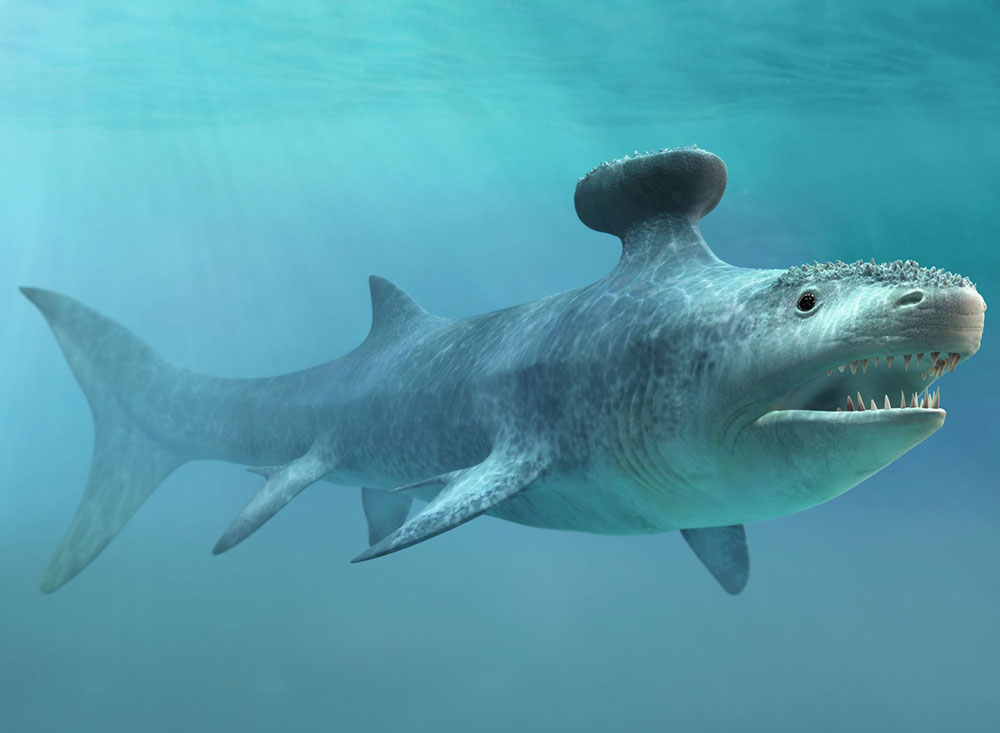
The Stethacanthus was a relatively small shark, only reaching around 70cm in length, and is believed to have been a coastal dwelling creature. Most likely avoiding the deeper water where the real giant monsters of the ancient seas called home.
Fossil collections have scientists of the belief that this shark migrated to specific breeding grounds at various times in its life.
22. Scissor Toothed Shark (Edestus) – More Teeth than Julia Roberts
Edestus is one of the ancient types of sharks that still confound scientists today as they try to glean more and more information from the different fossils discovered. View in gallery
What is known is that Edestus was a giant shark, measuring around 6 meters but possibly much larger. Unlike modern-day sharks – and many other prehistoric shark breeds – Edestus’s teeth did not fall out when they were old. Instead, new teeth and gum space grew in the rear of the mouth, pushing the existing teeth and jaws forward. This is how it got the now of a scissor-toothed shark because of how its jaw would keep growing until it looked like a set of shears or scissors.
Other than their jaws’ size and general shape, science has yet to determine how Edestus hunted or what impact its ever-growing jawline had on its evolution.
23. Megalodon – The King of Kings!
The great white might be the king of the modern-day seas, but the megalodon ruled over the prehistoric ocean like a true boss! The largest shark that ever lived, it grew to around 18 meters in length. This is three times longer than the largest great white.
View in gallery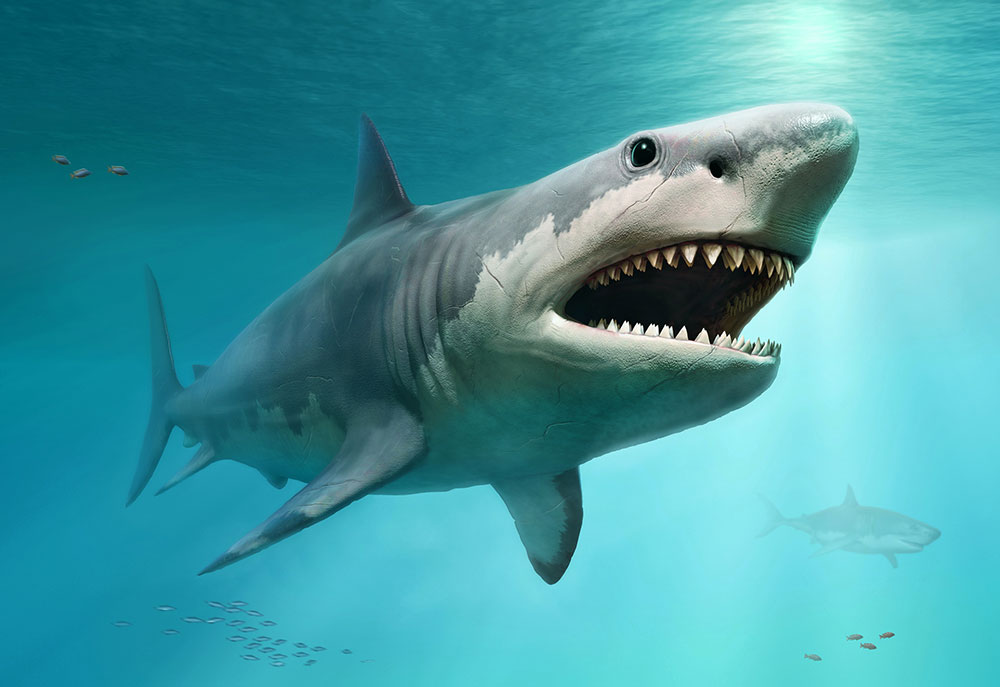
Megalodon’s teeth have been discovered measuring an incredible 18 cm, meaning it was big enough and bad enough to eat whatever it chose to eat at any given time. In fact, the meg was the ruler of the seas for over 20 million years.
A giant creature takes a giant bite. The megalodon had an estimated bite radius of up to 3.5 meters and a force of anywhere up to 180,000N. This is ten times stronger than the great white and 100 times stronger than a human! There is a reason the megalodon has been such a popular creature for works of fiction. It is a true mega-machine and will long reign as the ultimate badass on any list of the different types of sharks.
What Drives Our Love Affair with Sharks?
As I mentioned at the start, I love sharks. I always have done. They are just fascinating creatures, and it’s not just because of the Great White. It’s all sharks. I’ve written fiction novels about Megalodon, and I’ve voluntarily studied sharks for my own enjoyment. Not in the ocean but online, of course.
But that got me thinking: What is it about these apex predators that drives humanity’s love affair with them? I mean, you don’t see people getting all excited for Giraffe Week or Marmoset Month on National Geographic, do you?
Sharks make fantastic movie villains. We’ve had Jaws, 47 Meters Down, The Shallows, The Meg, Deep Blue, Sharknado, just to name a few. However, despite our love of casting them as man-eating monsters with the power to sink ships of any size, we all know that they are really majestic creatures. Sharks are fascinating, and the more we learn about them, the more we realize there is to learn.
Sharks have been a part of history for many years, dating back to the tales of sea monsters and dragons. Way back when, many centuries ago, sharks’ teeth would be thought of as dragon teeth.
It could also be because, in order to conquer the world, humankind took to the seas. From exploration to trading and travel, the sea was the only way to move from landmass to landmass until the Wright brothers came along.
I’m no Matt Hooper, nor am I a psychologist in any way, shape, or form but shark sightings, stories of sea monsters, and a superstitious society is a great breeding ground for a magical relationship that transcends generations.
Fear Drives Interest in All Different Types of Shark
Fear has to be the number one element when thinking deeper about what drives the connection between humanity and sharks. From those seafaring days with talk of oceanic monstrosities and confusion with dragons to the modern day where the merest tickle of seaweed at the beach has us imagining hungry jaws snapping shut on our flesh.
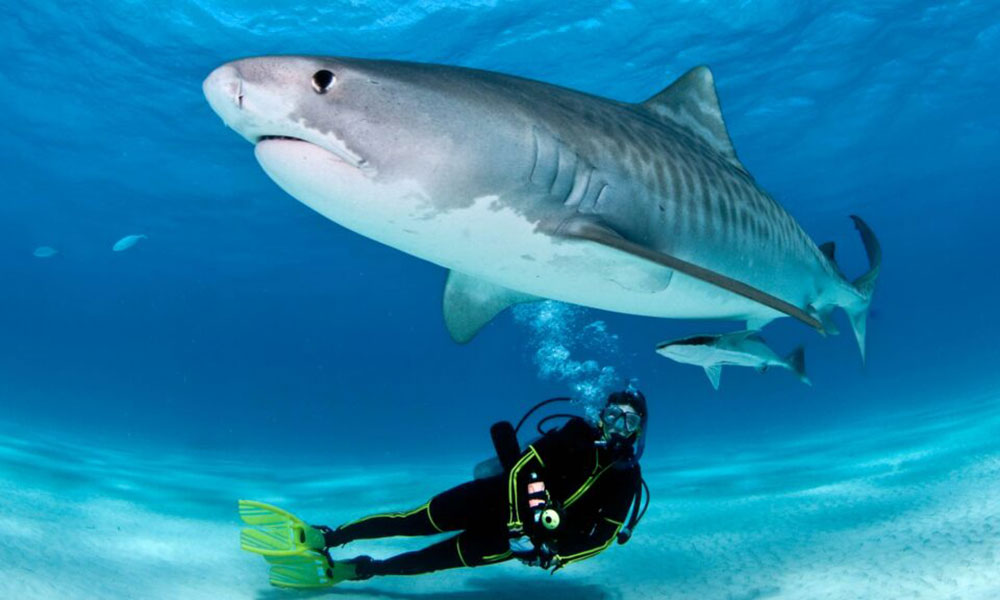
We fear sharks, and we respect sharks, and that is an intoxicating combination of emotions. Yet, despite all the things we have seen and learned, and with each new tidbit that comes into Shark Week programming, no amount of knowledge could best even the slightest smattering of fear; the lingering doubt that lives in the back of our minds.
The reality is that sharks do not pose a huge risk to human life. Yes, there are shark attacks each year, but that is not because there is a shark conspiracy, and they are hunting us down.
If you ask me, I think our fascination with sharks is more because we see ourselves as the king of the food chain on land. Sharks are the king of the ocean. We are intrinsically connected, eternally walking the same path but on different terrain. We fear them because we respect them, and we respect them because we understand there is so much we do not know about them.
Fearsome Predators In Ever Dwindling Supply
Despite our everlasting love affair with sharks, we are slowly doing everything we can to remove them from this planet. I say this not in approval but disgust.
Each year it is thought that we kill millions of sharks. That’s a heck of a lot more damage to them than they do to us.
Between 1970 and 2018, shark numbers globally dropped by a staggering 71% driving many species, including more than a few of the ones on this list, to the point of extinction. As a result, over 30 different types of sharks are currently on the red list of endangered species.
This sharp decline is due to the continued hunting and ‘finning’ of sharks, with the near criminally unregulated fishing waters of the Indian Ocean being one of the worst perpetrators of this fishy genocide.
It would seem that our interest in sharks, while deep-seated, is not quite as powerful as the needs of a small few to see them destroyed. This is not a soapbox post, but there is a stark reality in the dwindling number of sharks in our oceans. Should things not change, our love affair will come to an unfortunate end.
By the Numbers: Most Endangered Shark Species
Given the above stats, it’s only fair we look at some of the most endangered types of sharks. So that just maybe, something can be done to stop the decline in numbers and make sure our seas are shark-infested for future generations too.
- Pondicherry Shark
- Daggernose Shark
- Smoothback Angel Shark
- Northern River Shark
- Striped Smooth-Hound Shark
- Ganges Shark
- Borneo Shark
- The Great Hammerhead
- Natal Shyshark
- Porbeagle Shark
These are just some of the different sharks currently on the endangered list. Of course, for some, the placement is more critical than others, but the stark reality is that we are systematically ridding the world of these beautiful creatures.
24. Pondicherry Shark
The Pondicherry shark is, without question, the most endangered shark species in the world. This shark is indigenous to the indo-pacific ocean; however, between 1979 and 2016, there were no confirmed sightings of this shark. As a result, many scientists believed it was already extinct. However, it has since been sighted in some Sri Lankan rivers.
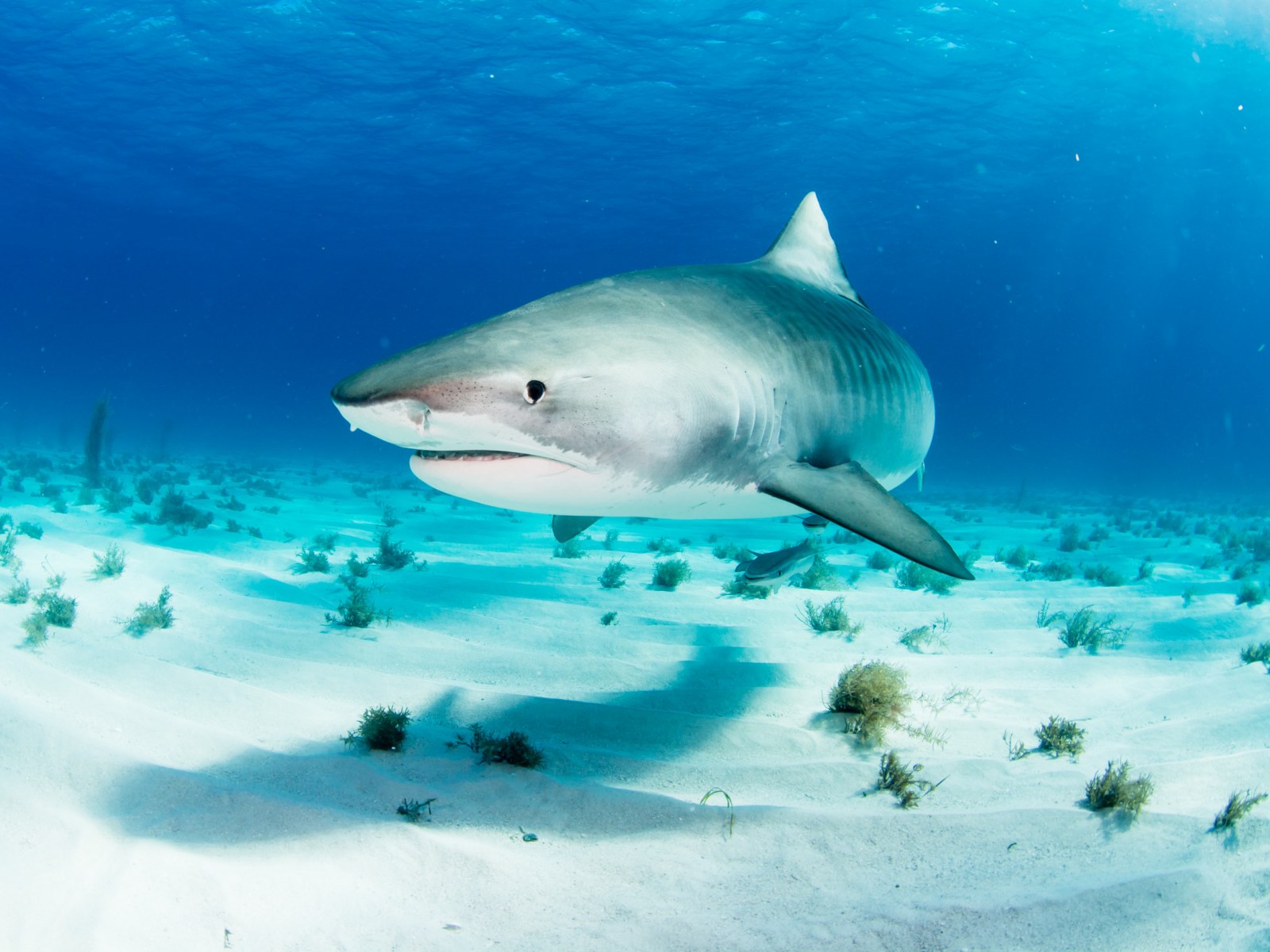
A small shark, the Pondicherry only reaches a meter in length and poses no threat to humans. Yet, it was fished extensively and used for meat. A predominantly inshore shark, it makes for an easy target for fishermen off the coast of Borneo and Java. So despite its extreme scarcity, it was still being sold on fish markets in small Sri Lankan villages.
25. Ganges Shark
The Ganges shark is a critically endangered freshwater river shark. A fully matured Ganges shark reaches around 2 meters and is prized for its fins and jaw instead of its meat.
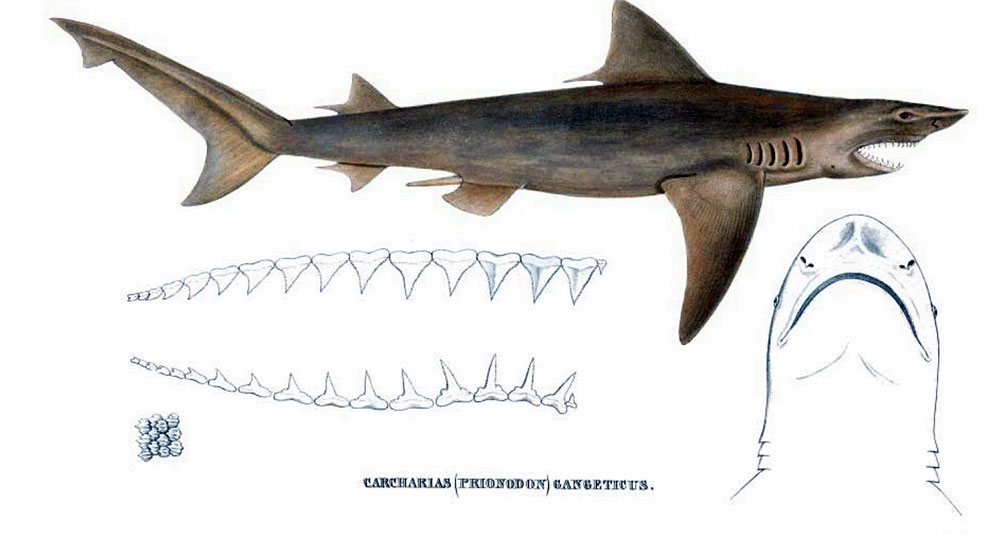
However, being intolerant to saltwater, this small shark’s population has suffered as a result of pollution coming from the land and artificial efforts such as dam building also. The exact number of Ganges sharks is unknown; however, they were low enough for the Indian government to issue a complete ban on fishing.
26. Borneo Shark
It should not be surprising that most of the endangered shark species are those indigenous to the indo-pacific regions, where fishing regulations are sparse, and their enforcement is infrequent. While conservationists are actively campaigning to toughen up these regulations, it will take enforcement in these less affluent areas to make a real difference.
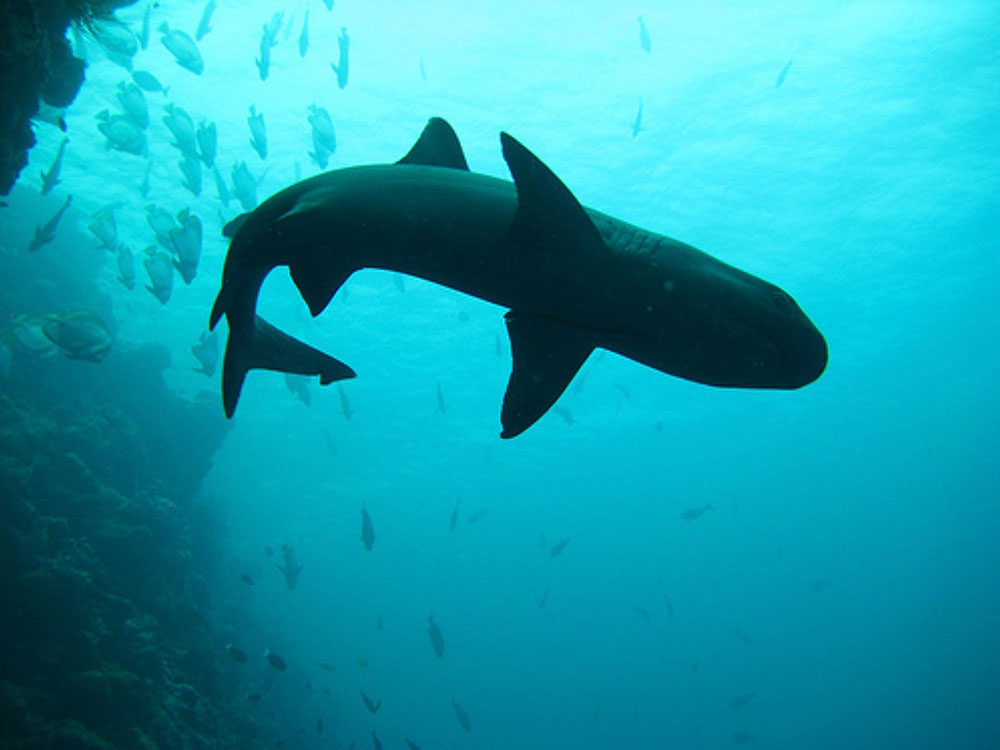
Take the Borneo shark, which was not sighted between 1934 and 2004 and seemingly disappeared again in 2017. While there are no accurate numbers, the severe lack of sighting means the Borneo shark is one of the most endangered types of sharks on earth.
Our Favorite Types of Sharks: Conclusion
Out infatuation with sharks is engrained into our psyche. We seem to have a connection with these majestic beasts that cannot be defined or broken. While their numbers are decreasing, sharks were here before us, and they will be here long after we have departed.
Sharks are the unrivaled sovereign of the seas, and rightly so. They are amazing and fascinating creatures. From large to small, no two shark species are the same. We barely scratched the surface with our list of the best types of sharks. There are so many that were also deserving of a mention.
What is your favorite kind of shark? Have you ever been swimming with sharks or had an encounter of some kind? I’d love to hear about them, so let us know in the comments. Do you feel there are different sharks that need to be included? Again, let us know.






I congratulate you for what I perceive as a well written, and I assume factual, article. No click-bait and few egregious grammatical / writing errors. You have written something that other would-be authors should study and seek to emulate!
We couldn’t thank you more. It was hard work, but truly happy with what we came up with. Thak you for the kind words.